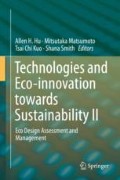Abstract
In Japan, recycling of precious and critical metals from used products is important. Although a legislation of recycling of small-sized home appliances has been enforced from 2013, return rate of such used products is very low and needs some countermeasures. Especially, reduction of the cost of recycling process is very important. Based on the situation, the study focuses on how to extract useful resources from used small electronics. As one of the methods, the study has proposed a new recycling method named remote recycling. Remote recycling is an idea to reduce such cost for screening by operating the system from remote places where labor cost is relatively cheaper. The objective of the study is to investigate the effectiveness of remote recycling for many kinds of small electronics and to show that the method is hopeful. In the previous studies, the author’s research group has tried to measure material compositions of screened particles and clarified that the method has a certain effectiveness. However, the metal densities may vary due to products. The study compared metal compositions of other small electronics with those of mobile phones and also tried to compare material compositions of manually disassembled printed circuit board (PCB) with remotely separated particles. The comparison showed that the total recoverable value by remote separation is lower than that of manual disassembly by 10–20%. But, 70–80% of the total value could be steadily recovered, whatever the product was. In total, remote recycling can be one solution to boost circular use of natural resources. Through these discussions, the study concluded that the newly proposed method, “remote recycling,” is a promising way to realize high-quality and low-cost recycling of small electronics.
Access this chapter
Tax calculation will be finalised at checkout
Purchases are for personal use only
References
Mishima N, Torihara K, Hirose K, Matsumoto M. A proposal on remote recycling system for small-sized E-waste. Proceedings of 2015 International Conference on Concurrent Engineering, Delft, Netherland; June 2015. p. 46–53.
Oki J, Torihara K, Kadowaki Y, Mishima N. A study on separating characteristics of metals towards remote recycling. Procedia CIRP. 2016;40:274–9.
Oikawa A, Oki J, Torihara K, Kadowaki Y, Mishima N. Remote operation experiment towards implementation of remote recycling. Proceedings of electronics goes green 2016+. Berlin, Germany; 2016. p.1–6.
Ministry of Environmental. http://www.env.go.jp/recycle/recycling/raremetals/. Accessed 25 Oct 2016.
The Japan Magnesium Association. Price fluctuation of magnesium. http://magnesium.or.jp/. Accessed 19 Jan 2017.
LME. Price fluctuation of Al, Ni, Cu, Zn. https://www.lme.com/. Accessed 19 Jan 2017.
ABC corp. Price fluctuation of Ti. http://abcmetal.jp. Accessed 19 Jan 2017.
Nippon Steel and Sumitomo Metal Corporation. Price fluctuation of Cr. https://nssc.nssmc.com/updates/prices.jp/materials. Accessed 19 Jan 2017.
Japan Iron and Steel Recycling Institute. Price fluctuation of Fe. http://www.jisri.or.jp/. Accessed 19 Jan 2017.
TOCOM. Price fluctuation of Au and Pb. http://www.tocom.or.jp/jp/. Accessed 19 Jan 2017.
Ohata Corp. https://www.ohata.org/. Accessed 19 Jan 2017.
Takahashi K, et al. Resource recovery from mobile phone and the economic and environmental impact. J Japan Inst Metals. 2009;73(9):747–51. (In Japanese).
Author information
Authors and Affiliations
Corresponding author
Editor information
Editors and Affiliations
Rights and permissions
Copyright information
© 2019 Springer Nature Singapore Pte Ltd.
About this chapter
Cite this chapter
Hirose, K., Oikawa, A., Oki, J., Torihara, K., Mishima, N. (2019). Examination of Effectiveness of Remote Recycling Through Material Composition Measurement of Used Small Electronics. In: Hu, A., Matsumoto, M., Kuo, T., Smith, S. (eds) Technologies and Eco-innovation towards Sustainability II. Springer, Singapore. https://doi.org/10.1007/978-981-13-1196-3_14
Download citation
DOI: https://doi.org/10.1007/978-981-13-1196-3_14
Published:
Publisher Name: Springer, Singapore
Print ISBN: 978-981-13-1195-6
Online ISBN: 978-981-13-1196-3
eBook Packages: Earth and Environmental ScienceEarth and Environmental Science (R0)

